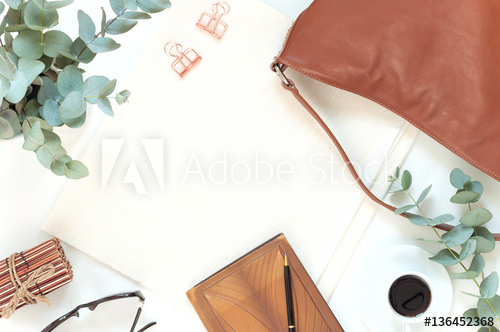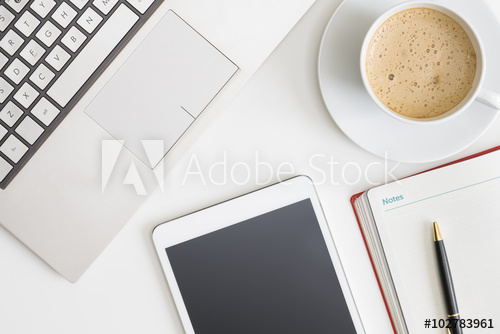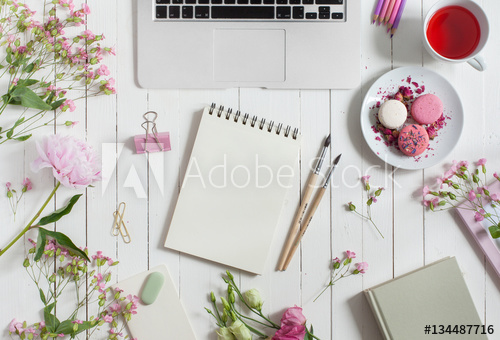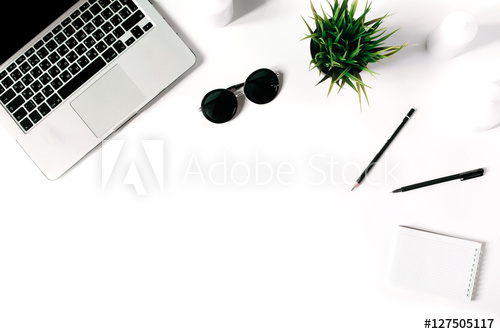Visual Storytelling Case Study #4: The FLAT LAY
Hey folks! Lets look at some of the more typical "flat lay" (still life photos shot from above) styles we see all over Instagram and Facebook these days. These ones are from stock photo sites, but I'll bet they look familiar to you:
These represent just a tiny, teensy little sliver of what's possible with this art form. But if you are a content marketer on Instagram and/or Facebook, you have probably seen pictures JUST like this everywhere.
Sometimes, you find something that follows the visual structures of the flat-lay, but breaks the mold and does something different. Sometimes, you begin to see how much potential there is.
The best flat lays are little visual theaters. the objects are characters in their own way, telling a unique story of a moment, a day, a collection, a life, a vocation. They are intimate, engaging, complex and speak to the intimate relationships we have with the objects in our lives.
The worst flat lays? Sanitized, conformist BS. These very trendy images are a perfect place to observe the most damaging ideologies of dominant entrepreneurial culture in the online spaces, as expressed through a very narrow visual story.
If you are thinking - oh no! I really like those images! Don't feel bad. They are designed for you to like them! I like many of them too. But lets turn a critical eye on them, and see what we learn.
In this case study I'm going to break down the ideology of the ubiquitous trendy flat lay style of the moment. If you wanna go down that rabbit hole with me, keep reading. Because when you understand the visual language of the dominant over-culture, you can understand how to better challenge it, and find your own visual story on your terms.
If you want to go straight to inspiration and prompts for creating your own unique flat lays, rich with your own visual storytelling, head to part 2.
PART ONE: What does the typical flat lay communicate?
1. Purity, Cleanliness, Perfection.
The white that dominates most of these flat lays is not a light that illuminates or reveals.
It is a white that conceals.
This white is about purity - akin to the white museum or gallery space. We have come to equate the white gallery space as a place of unlimited possibility...a neutral, content-less space, a blank canvas, the blank page, against which everything shines and sparkles. But this kind of easy contrast is problematic.
In his book "Inside the White Cube," Patrick O-Dougherty deconstructs the hidden ideology of the "white cube" of the museum or gallery space. He explains how the idea that ANY kind of space can be an objective and neutral, separated from social, cultural or other economic contexts is a myth -- and a central tenet of much western and colonial domination. The empty space of the gallery actually cuts the relational power of art off at the knees, removing it from context, positioning it as separate from daily living.
This is, in fact, part of the ideology of white supremacy: that there is something called "white" people (the pure, the good, the elevated, the standard, the norm, the best) and a white state of being, a pure form out of which all truth emerges. It lays the ground for all kinds of appropriation, theft and exploitation (visualize the white museum space with "artifacts" of indigenous cultures around the world, displayed for Western consumption.)
The pure white flat lay does something similar: it is a device that renders all that enters it apparently free from constraints of real daily living, time, and specificities of geography or culture. It is the fetishized idea of a "perfect" work life - but by what standards? And that is what we will explore next.
But first, I want to provide a reassurance:
This doesn't mean that white - as a color and as a function of light and space - is bad, or is not beautiful, or that we cannot use it. White, as a visual phenomena, is incredibly beautiful, and changeable, and variable, and strange -- and it communicates so much more than the ideology of white supremacy. But when it is the primary visual agent of erasure, purity, cleanliness, neutrality, and source of all - we are triggering in ourselves and others an ideology of purity and perfection which doesn't serve. So, how do you wanna use your white?
For an example of someone who uses white as a light that reveals (rather than a white that erases) see my post on Laura Letinsky's work.
2. Productivity Without Bodies
Notice: The coffee is usually unsipped in these images, with the foam heart still sparkling on top. Bonbons and cupcakes are unbitten, the bowl of glistening berries untouched. There are flat screens with no fingerprints, pencils brand new, sharp, and unused, plants unbruised, tables unsmudged. One gets the distinct feelings that there is not a body doing this work; that the office supplies and technological devices are doing it all by themselves.
Because bodies are messy, unpredictable. They don't operate strictly on market time. They are often unproductive. They have feelings. Oils. Odors.
So much work culture in our world is based on exploitation: of natural resources, of bodies AS natural resources, to be mined for productivity, to be forgotten as sovereign beings, ignored, used, overlooked, replaced when worn.
Professionalism has come to be related with an absence of the body. The more professional you are, the more moderated your voice, the more covered your skin, the more unobtrusive your bodily functions, the more packaged your presentation: not a flyaway hair out of place.
Professionalism is also equated with maleness, whiteness, thinness, heterosexuality: more of this mythological norm.
These flat lays are packaged and smooth, unsullied by use, by feelings, by time, by effort, by struggle and by diversity and anomaly. They comprise a visual language that has parallels to beauty standards for women, and class/race/status standards for all people. And they signify a fascination/preoccupation with domestic consumer objects, which is, among other things, a major feature of internalized sexism for women. Which brings me to...
3. The commodification of feminism + the fetishization of domestic objects
The sanitized flat lay is part of what happens to feminism as it is coopted into the entrepreneurial world’s visual landscape. Its the way that the collective liberation and societal transformation that radical (intersectional) feminism stands (and stood) for has been distorted -- and come to indicate individual "freedom," wealth, and conformity to class and beauty standards that are anything but feminist.
The visual culture of the online entrepreneurial world helps create the archetype of the perfect entrepreneurial woman. She’s thin, sexy (by conventional standards), straight or at least cisgendered, white, wealthy, spiritual, and exudes positivity and the ability to manifest anything she wants, free from the constraints of societal institutions and oppressions. She is privilege embodied, sometimes even in a package that says “I’m for social justice.” Of course, she doesn’t exist – she is an image, and ideal, against which we are all supposed to compare ourselves. And the closer we are in proximity to that image (in those places where our identities or circumstances bring us closer to that mythical norm), the more we are encouraged to take on that archetypal images into our own visual brand – thereby leveraging its oppressive language on our own behalf. Yuck, right?
So how do these flat lays contribute to it?
The romantic flat lay desktops are made primarily by and for women. The objects that signify more traditionally "male" aspects of work (the keyboard, the glasses, the calculator, and other signifiers of skill, work and productivity) are counterbalanced by signifiers of "femininity" (within a sexist narrative) - a pink pencil, a sparkly earring, makeup, a compact mirror, a heart-shaped container, a pink notebook. Its part of the bigger cultural archetype we see everywhere now, of the woman who "has it all" - a happy family, a job that provides piles of cash, the ability to travel and "work from anywhere," a thin, fashionable, light-skinned body, and a great sex life. She is "free," but only within the confines of the dominant culture's narrow definition of the acceptable feminine.
Remember: in a society based on sexism with capitalism at the helm, women are commodities.
Long before we started businesses and began equating ourselves with our business's brand, we were already brands. We already fit, or didn't, into very deeply rooted cultural archetypes for women, and were celebrated or punished (or both) based on our ability to conform (or not) to those brands.
As women, our identities have been inseparable from the DOMESTIC for eons. We are the biggest consumer base in the world, and it is household goods that we consume. We have been trained to see our value and our worth as related to our successes in the domestic sphere. So it's no wonder that we have been deeply conditioned to fantasize about and adore consumer objects from the home. Think of how many young girls create dream worlds inside of dollhouses.
We are vulnerable to feelings of longing for the objects and signifiers of domestic beauty. Which makes us vulnerable to images that will trigger our longing for a perfect work-at-home desktop.
We may be on the edge of our skill sets, our courage, and our sleep cycles in trying to build a business - and in these conditions, a desktop that feels like success can give us a lot of reassurance, am I right?
So, clearly the fetishizing of pink pencils and fancy planners and (lets not even get started with) Apple products is a clear vocabulary of sexism and classism, and boring to boot.
So what to do?
I believe we have a real human need for a sense of connection to - and appreciation of - objects. Without the confusions installed by mass production, sexism, and more, I am sure we would still treasure objects. They would be made, shared and used with a sense of reciprocity with the land and each other. We would not exploit the environment in degrading ways, or exploit other humans as laborers, in the creation and use of objects. Each object would hold embedded meanings and histories that we would be aware of and appreciative of. There is a more ancient longing here -- and a real need -- that is not being met by our current obsession with mass produced objects.
PART TWO: Liberate the Flat-Lay!
Let's turn our inherent love for and connection to objects and spaces into gorgeous, drool-worthy flat lays that tell powerful visual stories, communicate the heart of our work and values, change culture and defy the icky norm. Shall we?
The setup of a flat lay is magical. It turns your tabletop into a little theater in which objects become special just by being placed there. The edges of the photo are a window into a miniature world, a language of its own, in which the objects are the vocabulary. When you break out of the standard tropes that are dominating the current visual culture, suddenly the format of a flat lay becomes like any great set of creative parameters. It offrs a container inside of which the limitless can happen.
TIPS, ADVICE, and PERSPECTIVES for ROCKING YOUR FLAT LAY:
1. Remember that authenticity can mean many things - it doesn't have to mean bald honesty about the actual state of your desktop. This is art, people. So go ahead and create a magical theatrical desktop of imagination. Your creative imagination as expressed in this form is just as authentic to you as your actual desk with the dried hummus on the keyboard and the dirty sock falling off the edge. Your creative genius is authentic and your own internal visual language is variable, complex, layered, endless. Don't get too stuck in the "real." REAL is bigger than what you see in the day-to day.
2. Embrace beauty. Some folks, in rejecting the super-stylized look of the flat-lays, think that its stylization ITSELF that is the problem. Not so. Its the homogeneity and vacuousness of the current trendy forms of stylization that are such a bummer. If you don't go ahead and claim BEAUTY and intentionality in your artistry, you'll lose likes, hearts and followers. You just will. We respond to tender loving care, and you get to be fully invested in your creative process, and in the pursuit of beauty. So set up good lighting. Take time to compose. Get into your own love for the objects, shapes and colors you're using. Feel the beauty yourself and capture it. Delight yourself in the process, and your viewers will take delight too.
3. Lighting matters. I suggest purchasing/gathering at least 4 small clamp-lights from the hardware store and arranging them to point at your tabletop from different places nearby. This will help reduce cast shadows (unless you are deliberately using shadow as a part of your composition). Do your photography in a room with lots of natural light early in the day, if possible.
4. Think about some overall visual parameters for your social media graphics generally. Example: if you have an Instagram account, how do you want your feed to look overall? Does your brand already have a color palette you want to conform to? If its been a while since you really thought about your visual brand, dust it off. Your photoshoots here will help evolve your brand, refresh it, give it more dimension, color, texture and story.
5. Gather materials. Once you have thought through some of your existing visual brand parameters, gather materials. If your brand colors are pumpkin, eggplant and sage, you might go to the art supply store and purchase 3 large sheets of paper in each color to provide backgrounds for your flat lays; then you can alternate the colors in your Instagram feed for a vibrant effect. You can also find interesting papers you can write on, labels and letter cut-outs, anything that can help you build your space with color, shape and text.
6. Open up your relationship to objects: Your flat lay doesn't have to include only objects that directly symbolize parts of your practical business life, such as keyboards and pencils. The heart of your work is about so much more. If fun and creativity are core values of your work, for example, what happens when you simply search for FUN objects? There are MILLIONS of those out there! Set aside a box in your office where you gather interesting objects you find in your home, in nature, in thrift stores and flea markets, in the supermarket - anything that catches your eye. Just get a collection going that you can keep adding to over time. Don't overthink what goes in your box - you want a lot of raw material. Sometimes certain objects don't mean much until they are paired with other objects, and then it just "works." Just collect stuff you like or are drawn to.
7. Playtime! Once you've got a tabletop, some lights, some papers and colors, a box of objects, spend a few hours just arranging and playing, photographing along the way. This is important: DON'T JUDGE while you are playing! Just arrange, shoot, arrange, shoot, for a good long time without worrying about the final result. Play with the relationships of the objects to each other; play with colors, with composition. Notice how the look or meanings of objects seem to change as the objects or composition change around them. Have fun! Go for quantity rather than fussing over each image. Try to take 100 photos in one session (make sure your phone/camera has lots of storage space)!
Some prompts to help your play, if you need them:
Explore the relationship of 2D to 3D. What if you use printed photos, magazine images or other printed 2D images in your in your flat lay along with your 3D objects? What strange phenomena and relationships can happen between images and objects?
Explore handmade text. Most people bring their images into Canvas or Photoshop and add text digitally. If you want a word or sentence in your flat lay, how about handwriting it right into the scene? Or cutting words out of books and magazines? Using punch-out type labels? Where else can you find text and type in the physical world that you can include in your flat-lay?
Play with light, shadow, reflection and transparency. Set up simple scenes, then remember that the strange visual phenomena that light can offer are totally part of the drama. Is your theater a little shadow puppet show? How does light bounce off of marbles, glassware, etc? Darken your room and play with spot lighting. Play with mirrors, objects seen through lenses, etc.
8. Curate! Each individual image may tell a powerful visual story, but groupings of images can amplify and complicate the meanings (in good ways). Give yourself lots of time to group and cluster images, putting the ones you think you'll never use into a different folder.
HAVE A BLAST creating your own GORGEOUS, CREATIVE, MAGICAL, INNOVATIVE flat lay images.
Come share your creations on Facebook at the Tactical Imagination Club (and everywhere else), and post on Instagram with the hashtag #flatlayrebellion! Let's evolve the art form and raise the standards. Have fun!
Coming up next: slideshows of flat lays that break the mold and inspire.




